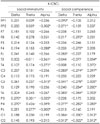Abstract
Objective
This study examined the association between the wave form in quantitative electroencephalography (QEEG) and the cognitive and behavioral characteristics measured by the Korean version of Wechsler Intelligence Scale for Children 4th edition (K-WISC-IV), Korean version of the attention deficit/hyperactivity disorder Rating Scale (K-ARS), and Korean version of Child Behavior Checklist (K-CBCL) in children diagnosed with ADHD.
Method
A retrospective cross-sectional study was performed on children aged 8 to 13 years, who were diagnosed with ADHD at Samsung Medical Center from November 2011 to March 2017. A total of 57 ADHD children were selected by a medical chart review. Their QEEG findings and psychological test results, including K-WISC-IV, K-CBCL, and K-ARS (n=42), were collected. The QEEG was analyzed by the ranges of Hz: delta (1–4 Hz), theta (4–8 Hz), alpha (8–12 Hz), and beta (12–25 Hz) and transformed to the z-scored relative power. The collected data were analyzed using Pearson and Partial correlation analysis.
Results
The Letter-Number Sequencing scores of K-WISC was positively correlated with fronto-central alpha. The hyperactivity/impulsivity scores of K-ARS were positively correlated with the theta/beta ratio. Among the items of K-CBCL, social immaturity was positively correlated with delta and theta, and negatively correlated with alpha. Social competence was negatively correlated delta and theta, and positively correlated with alpha.
Figures and Tables
Table 1
Baseline characteristics in children with ADHD (n=57)

ADHD : Attention deficit/hyperactivity disorder, NOS : Not otherwise specified, SD : Standard deviation, K-WICS-VI : Wechsler Intelligence Scale for Children 4th edition, K-ARS : Korean version of the attention deficit/hyperactivity disorder Rating Scale, K-CBCL : Korean version of the Child Behavior Check List, FSIQ : Full Scale Intelligence Quotient, VCI : Verbal Comprehension Index, PRI : Perceptual Reasoning Index, WMI : Working Memory Index, PSI : Processing Speed Index
Table 2
Pearson's correlation coefficient(r) between K-WISC-IV, K-ARS sub-scales and z-scored relative power in 19 cortical regions in attention deficit/hyperactivity disorder patients

References
1. American Psychiatric Association. Diagnostic and statistical manual of mental disorders: DSM-5. 5th ed. Arlington, VA: American Psychiatric Publishing;2013.
2. Polanczyk G, de Lima MS, Horta BL, Biederman J, Rohde LA. The worldwide prevalence of ADHD: a systematic review and metaregression analysis. Am J Psychiatry. 2007; 164:942–948.

4. Barry RJ, Clarke AR, Johnstone SJ. A review of electrophysiology in attention-deficit/hyperactivity disorder: I. Qualitative and quantitative electroencephalography. Clin Neurophysiol. 2003; 114:171–183.

5. Snyder SM, Hall JR. A meta-analysis of quantitative EEG power associated with attention-deficit hyperactivity disorder. J Clin Neurophysiol. 2006; 23:440–455.

6. Snyder SM, Quintana H, Sexson SB, Knott P, Haque AF, Reynolds DA. Blinded, multi-center validation of EEG and rating scales in identifying ADHD within a clinical sample. Psychiatry Res. 2008; 159:346–358.

7. Arns M, Conners CK, Kraemer HC. A decade of EEG Theta/Beta ratio research in ADHD: a meta-analysis. J Atten Disord. 2013; 17:374–383.
8. Clarke AR, Barry RJ, McCarthy R, Selikowitz M. EEG-defined subtypes of children with attention-deficit/hyperactivity disorder. Clin Neurophysiol. 2001; 112:2098–2105.

10. Loo SK, Makeig S. Clinical utility of EEG in attention-deficit/hyperactivity disorder: a research update. Neurotherapeutics. 2012; 9:569–587.

11. Clarke AR, Barry RJ, McCarthy R, Selikowitz M. Excess beta activity in children with attention-deficit/hyperactivity disorder: an atypical electrophysiological group. Psychiatry Res. 2001; 103:205–218.

12. Robbie JC, Clarke AR, Barry RJ, Dupuy FE, McCarthy R, Selikowitz M. Coherence in children with AD/HD and excess alpha power in their EEG. Clin Neurophysiol. 2016; 127:2161–2166.

13. Clarke AR, Barry RJ, McCarthy R, Selikowitz M, Croft RJ. EEG differences between good and poor responders to methylphenidate in boys with the inattentive type of attention-deficit/hyperactivity disorder. Clin Neurophysiol. 2002; 113:1191–1198.

14. Arns M, Gunkelman J, Breteler M, Spronk D. EEG phenotypes predict treatment outcome to stimulants in children with ADHD. J Integr Neurosci. 2008; 7:421–438.

15. Monastra VJ, Monastra DM, George S. The effects of stimulant therapy, EEG biofeedback, and parenting style on the primary symptoms of attention-deficit/hyperactivity disorder. Appl Psychophysiol Biofeedback. 2002; 27:231–249.
16. Arns M, Drinkenburg W, Leon Kenemans J. The effects of QEEG-informed neurofeedback in ADHD: an open-label pilot study. Appl Psychophysiol Biofeedback. 2012; 37:171–180.

17. Arns M, Gordon E. Quantitative EEG (QEEG) in psychiatry: diagnostic or prognostic use? Clin Neurophysiol. 2014; 125:1504–1506.

18. Hermens DF, Soei EX, Clarke SD, Kohn MR, Gordon E, Williams LM. Resting EEG theta activity predicts cognitive performance in attention-deficit hyperactivity disorder. Pediatr Neurol. 2005; 32:248–256.

19. Loo SK, McGough JJ, McCracken JT, Smalley SL. Parsing heterogeneity in attention-deficit hyperactivity disorder using EEG-based subgroups. J Child Psychol Psychiatry. 2018; 59:223–231.

20. McGough JJ, McCracken JT, Cho AL, Castelo E, Sturm A, Cowen J, et al. A potential electroencephalography and cognitive biosignature for the child behavior checklist-dysregulation profile. J Am Acad Child Adolesc Psychiatry. 2013; 52:1173–1182.

21. American Psychiatric Association. Diagnostic and statistical manual of mental disorders (DSM-IV-TR). Washington, DC: American Psychiatric Publishing;2000.
22. So YK, Noh JS, Kim YS, Ko SG, Koh Y. The reliability and validity of Korean parent and teacher ADHD rating scale. J Korean Neuropsychiatr Assoc. 2002; 41:283–289.
23. Kim MY, Lee J, Kim YA, Ha EH, Oh KJ. Secular changes in behavior problems of Korean youths based on the Korean-CBCL and -YSR. Kor J Psychol Gen. 2015; 34:769–793.

24. Thatcher RW, Walker RA, Biver CJ, North DN, Curtin R. Quantitative EEG normative databases: validation and clinical correlation. J Neurother. 2003; 7:87–121.

25. Murtagh A, Hurley AL, Kinsella A, Corvin A, Donohoe G, Gill M, et al. The Letter-Number Sequencing Test and its association with potential to work among people with psychotic illness. Eur Psychiatry. 2010; 25:101–104.

26. Snyder SM, Rugino TA, Hornig M, Stein MA. Integration of an EEG biomarker with a clinician's ADHD evaluation. Brain Behav. 2015; 5:e00330.

27. Widagdo MM, Pierson JM, Helme RD. Age-related changes in qEEG during cognitive tasks. Int J Neurosci. 1998; 95:63–75.





 PDF
PDF ePub
ePub Citation
Citation Print
Print



 XML Download
XML Download